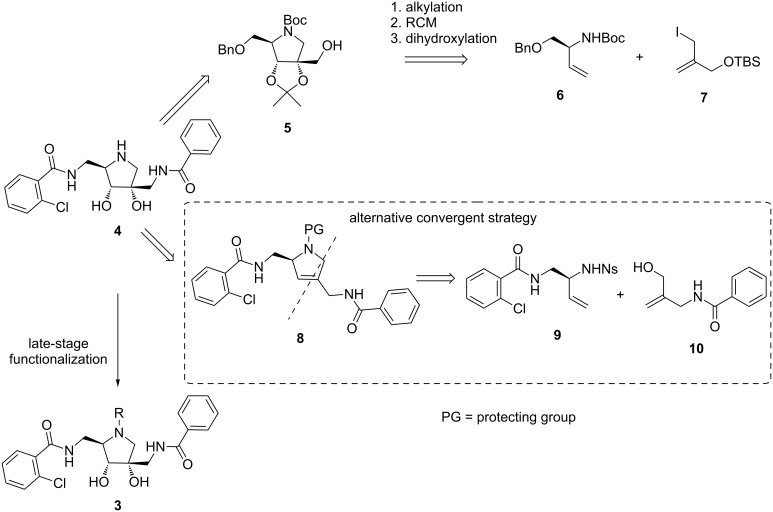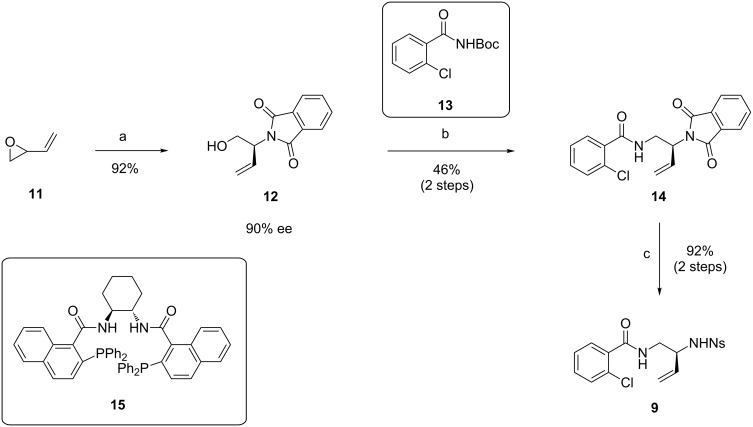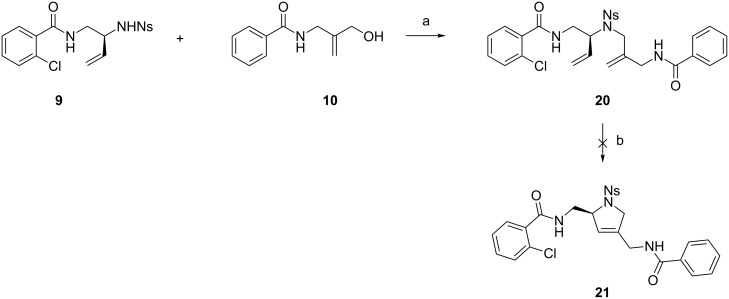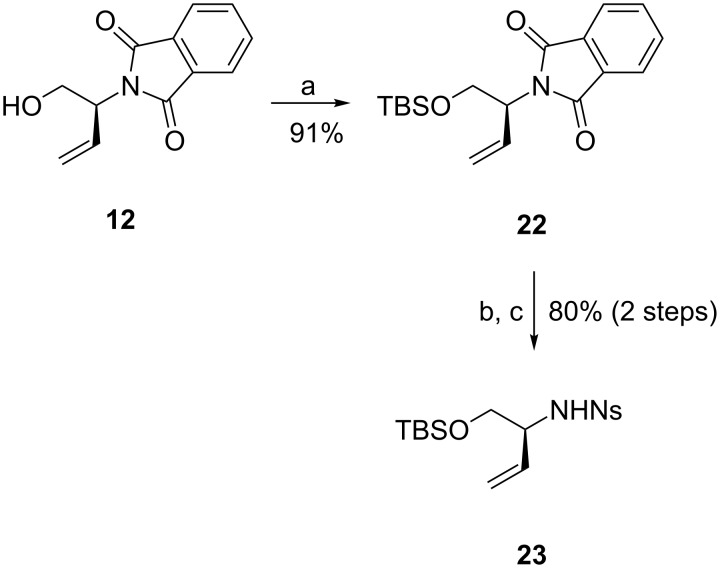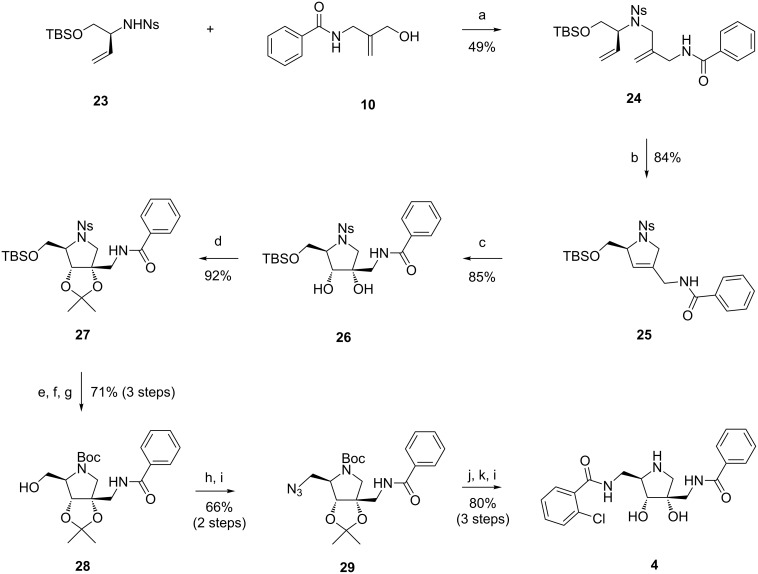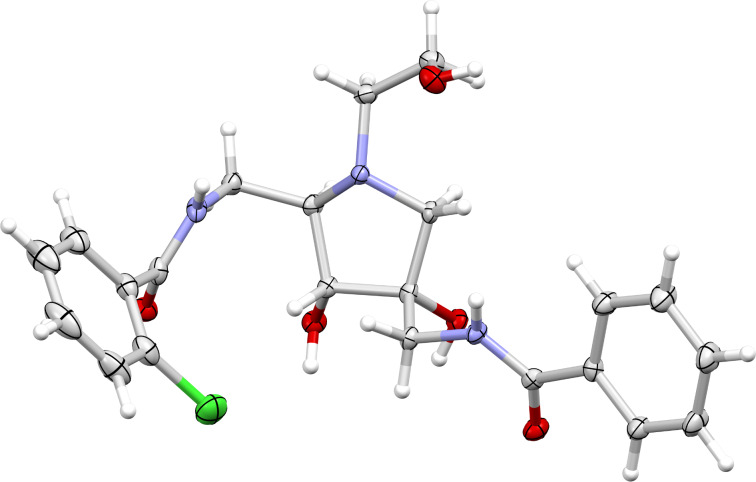Abstract
Interfering with bacterial cell-to-cell communication is a promising strategy to combat antimicrobial resistance. The natural product hamamelitannin and several of its analogues have been identified as quorum sensing inhibitors. In this paper the synthesis of pyrrolidine-based analogues of a more lead-like hamamelitannin analogue is reported. A convergent synthetic route based on a key ring-closing metathesis reaction was developed and delivered the pyrrolidine analogue in 17 steps in high yield. Chemoselective derivatization of the pyrrolidine nitrogen atom resulted in 6 more compounds. The synthesized compounds were evaluated in a biofilm model, but were all inactive.
Keywords: hamamelitannin, iminosugar, pyrrolidine, quorum sensing, Staphylococcus aureus
Introduction
Antimicrobial resistance is rapidly becoming a global threat [1–2]. It is estimated that worldwide, at least 700 000 people die every year from drug-resistant strains of common bacterial infections. Strategies to deal with the global antimicrobial resistance problem need to be multifactorial. Next to disease prevention and the development of new antibiotics, it is essential to investigate innovative strategies to combat bacterial infections [3–4]. Recently, targeting bacterial virulence has gained a lot of attention [5–7]. It has been hypothesized that by “disarming” the pathogen, rather than inhibiting its growth, selective pressure for resistance development will be much lower. Furthermore, reduction of bacterial virulence directly protects the host, and at the same time renders the bacteria more susceptible towards the host defense system and antibiotics.
The Centers for Disease Control and Prevention (CDC) have listed a number of bacteria that present serious, urgent and concerning threats [8]. One of these problematic bacteria is methicillin-resistant Staphylococcus aureus (MRSA), a human pathogen that causes a wide range of clinical infections. In S. aureus, virulence is mainly mediated by quorum sensing, a bacterial cell-to-cell communication system based on the secretion of signal molecules [9–11]. The natural product hamamelitannin (1) has been identified as a non-peptide analogue of RIP (RNAIII-inhibiting protein), an inhibitor of the RAP/TRAP (RNAIII-activating protein/target of RAP) quorum sensing system in S. aureus (Figure 1) [12–14]. Furthermore, hamamelitannin has been shown to inhibit biofilm formation and to potentiate the activity of antibiotics against staphylococcal biofilms in vitro and in vivo [12,15]. Structural optimization of hamamelitannin by our group resulted in several more potent and more druglike analogues of which compound 2 emerged as a promising starting point for further optimization and subsequent development (Figure 1) [16–19]. Our earlier work revealed that the optimal side chain substituents are an o-chlorobenzamide on the 5-position and a non-substituted benzamide on the 2’-position. In absence of any structural information of the inhibitor–target interaction, we were interested in replacing the core tetrahydrofuran scaffold by a pyrrolidine ring in order to further elucidate the structure–activity relationship. The pyrrolidine nitrogen atom provides an extra point of diversification, allowing further elaboration of the scaffold. Substituents on the ring nitrogen might lead to additional interactions with the target and therefore provide more potent analogues. Moreover, the O-to-N replacement is expected to increase solubility and possible polar interactions with the target. In this work we report the design, synthesis and biological evaluation of a number of pyrrolidine-based hamamelitannin analogues.
Figure 1.
Structures of hamamelitannin (1), lead compound 2 and target compounds 3.
The envisioned strategy for the synthesis of the target pyrrolidine-based hamamelitannin analogues is depicted in Scheme 1. The synthesis of 4 as a key intermediate allows to gain access to a diverse set of analogues by chemoselective late-stage derivatization of the pyrrolidine nitrogen. Previously, we used the iminosugar 5 to prepare a series of 2’-homoazanucleosides. This possible precursor was synthesized convergently in 12 steps [20]. The pyrrolidine ring was constructed via alkylation of 6 and 7, followed by ring-closing metathesis. Stereoselective dihydroxylation of the resulting alkene then furnished the protected iminosugar 5. However, using intermediate 5 as a starting point for the hamamelitannin analogues would render the synthetic route very linear and impractical to produce sufficient amounts required to prepare a series of analogues.
Scheme 1.
Proposed strategy for the synthesis of the target analogues.
Therefore, we envisioned a modification of the previously developed synthetic route, where the two fully functionalized side chains are introduced prior to coupling and ring closure to afford 8. This new synthetic route would be more convergent and efficient for the preparation of 3. Retrosynthetic analysis led to 9 and 10 as two key synthons, which would be assembled via a Mitsunobu–Fukuyama reaction, and subsequently the secondary amine converted to the pyrrolidine ring via a ring-closing metathesis reaction [21].
Results and Discussion
Chemistry
The synthesis of fragment 9 is depicted in Scheme 2 and proved to be challenging. It was essential to introduce the nosyl group only in the last step, since several previous attempts to synthesize 9 failed due to side reactions caused by the strongly electron-withdrawing properties of the nosyl group. The successful synthesis starts with a Pd-catalyzed dynamic kinetic asymmetric transformation of racemic butadiene monoepoxide to 12, employing phthalimide as nucleophile [22–23]. Attempts to substitute the alcohol functionality of 12 via displacement of the derived mesylate with NaN3 failed, similar to previously reported difficulties by Trost et al. [24]. The benzamide substituent was therefore introduced via Mitsunobu reaction with N-Boc-protected ortho-chlorobenzamide 13. Removal of the Boc-group with TFA resulted in 14. Next, the phthalimide was removed via refluxing with ethylenediamine and the resulting amine protected as para-nitrobenzenesulfonamide to obtain the desired fragment 9.
Scheme 2.
Synthesis of fragment 9. Reagents and conditions: a) phthalimide, Pd2(allyl)2Cl2, ligand 15, Na2CO3, CH2Cl2, rt; b) i) 13, DEAD, PPh3, toluene, 0 °C to rt; ii) TFA, CH2Cl2, H2O, rt; c) i) ethylenediamine, EtOH/THF 7:3, reflux; ii) p-Ns-Cl, Et3N, THF, 0 °C.
The synthesis of 10 starts from commercially available 2-methylene-1,3-propanediol (16), which was selectively monoprotected in high yield as TBS ether (Scheme 3) [25]. The remaining alcohol was then substituted for a phthalimide via Mitsunobu reaction. Phthalimide deprotection, acylation with benzoic acid, and removal of the silyl protecting group furnished 10.
Scheme 3.
Synthesis of fragment 10. Reagents and conditions: a) TBSCl, NaH, THF, rt; b) phthalimide, PPh3, DEAD, THF, 0 °C to rt; c) H2NNH2·H2O, MeOH, reflux; d) BzCl, Et3N, CH2Cl2, 0 °C; e) TBAF, THF, rt.
Fragments 9 and 10 were coupled under Mitsunobu conditions (Scheme 4), affording 20 contaminated with Mitsunobu byproducts. Unfortunately, attempted ring-closing metathesis of 20 using the Grubbs–Hoveyda II catalyst failed to produce any product, probably due to the insolubility of 20 in solvents suitable for metathesis reactions (1,2-DCE, toluene) and/or the coordinating ability of the three (sulfon)amide functionalities [26–27].
Scheme 4.
Coupling of 9 and 10 and attempted ring-closing metathesis. Reagents and conditions: a) PPh3, DEAD, THF/DMF 2:1, 0 °C to rt; b) 5 mol % Grubbs–Hoveyda II, 1,2-DCE, 50 °C.
To circumvent this problem, we were forced to alter the initial synthetic strategy and used a different eastern fragment for the ring-closing metathesis reaction. The ortho-chlorobenzamide substituent would then be introduced in a later stage. We chose to protect alcohol 12 as TBS ether and used the derived nosyl-protected fragment 23 as the coupling partner (Scheme 5).
Scheme 5.
Synthesis of alternative eastern fragment 23. Reagents and conditions: a) TBSCl, imidazole, CH2Cl2, rt; b) H2NNH2·H2O, MeOH, reflux; c) p-Ns-Cl, Et3N, CH2Cl2, 0 °C.
Fragments 23 and 10 were coupled via Mitsunobu reaction, yielding 24 in 49% yield (Scheme 6). Fortunately, ring-closing metathesis of 24 now smoothly afforded 25 in high yield. Dihydroxylation selectively yielded the desired stereoisomer of diol 26, which was subsequently protected as isopropylidene acetal. In the next step, after removal of the TBS group and mesylation, attempted substitution with NaN3 resulted only in an elimination product. This led us to replace the electron-withdrawing nosyl protecting group with a Boc group. After removal of the TBS ether and mesylation of the resulting alcohol, substitution with NaN3 now smoothly provided azide 29. The azide was then reduced under classical Staudinger conditions, followed by amide formation with ortho-chlorobenzoic acid and a final acidic deprotection step to provide the desired analogue 4. Despite the change of the initial strategy and resulting elongation of the synthetic route, the overall synthesis still proved to be very efficient, delivering 4 in 6% yield in 17 steps from 16.
Scheme 6.
Synthesis of 4. Reagents and conditions: a) PPh3, DEAD, THF, 0 °C to rt; b) Grubbs–Hoveyda II (5 mol %), 1,2-DCE, 50 °C; c) K2OsO4·2H2O, NMO, acetone/H2O 3:1, rt; d) 2-methoxypropene, CSA (cat.), THF, rt; e) PhSH, K2CO3, MeCN, 50 °C; f) Boc2O, Et3N, CH2Cl2, rt; g) TBAF, THF, rt; h) Ms-Cl, Et3N, CH2Cl2, 0 °C; i) NaN3, DMF, 60 °C; j) PMe3, H2O, THF, rt; k) 2-chlorobenzoyl chloride, Et3N, CH2Cl2, 0 °C; l) conc. HCl, MeOH/H2O 1:1, reflux.
The pyrrolidine nitrogen was then further derivatized with several small substituents (Scheme 7). Reductive amination with several aldehydes resulted in 3a–c. The N-methyl analogue 3d was synthesized via methylation with MeI. The methanesulfonamide 3e and acetamide 3f, in which the cationic character of the pyrrolidine nitrogen is removed, were also synthesized.
Scheme 7.
Late stage functionalization of the pyrrolidine nitrogen. Reagents and conditions: A) (masked) aldehyde, NaBH3CN, AcOH, MeOH, 60 °C; B) MeI, DIPEA, THF, 0 °C; C) Ms-Cl, Et3N, THF, 0 °C; D) AcOH, DIPEA, HATU, DMF, rt.
The correct stereochemistry of the synthesized analogues was unequivocally proven via X-ray structural analysis of compound 3a (Figure 2).
Figure 2.
Molecular X-ray structure of 3a, showing thermal displacement ellipsoids at the 50% probability level. Positional disorder of the chlorophenyl ring and the water solvent molecule are not shown.
Biological evaluation
The synthesized analogues were tested in a S. aureus biofilm model, but were all inactive (see Supporting Information File 1).
Conclusion
A convergent synthetic route for the synthesis of pyrrolidine-based hamamelitannin analogues was developed. The originally envisioned strategy failed due to difficulties in the ring-closing metathesis reaction, but modification of one of the coupling partners solved this issue. The desired pyrrolidine-based analogue was synthesized in 17 steps and chemoselective modification of the nitrogen atom provided 6 analogues. Unfortunately, these analogues were inactive in inhibiting S. aureus biofilm formation.
Supporting Information
Experimental details.
Acknowledgments
Izet Karalic is gratefully acknowledged for technical assistance. KVH thanks the Hercules Foundation (project AUGE/11/029 “3D-SPACE: 3D Structural Platform Aiming for Chemical Excellence”) and the Special Research Fund (BOF) – UGent (project 01N03217) for funding.
This article is part of the thematic issue "Antibacterials, bacterial small molecule interactions and quorum sensing".
References
- 1.The review on antimicrobial resistance. 2016. Tackling drug-resistant infections globally: final report and recommendations. [Google Scholar]
- 2.Ventola C L. P T. 2015;40:277–283. [PMC free article] [PubMed] [Google Scholar]
- 3.Czaplewski L, Bax R, Clokie M, Dawson M, Fairhead H, Fischetti V A, Foster S, Gilmore B F, Hancock R E W, Harper D, et al. Lancet Infect Dis. 2016;16:239–251. doi: 10.1016/S1473-3099(15)00466-1. [DOI] [PubMed] [Google Scholar]
- 4.Brown E D, Wright G D. Nature. 2016;529:336–343. doi: 10.1038/nature17042. [DOI] [PubMed] [Google Scholar]
- 5.Rasko D A, Sperandio V. Nat Rev Drug Discovery. 2010;9:117–128. doi: 10.1038/nrd3013. [DOI] [PubMed] [Google Scholar]
- 6.Heras B, Scanlon M J, Martin J L. Br J Clin Pharmacol. 2015;79:208–215. doi: 10.1111/bcp.12356. [DOI] [PMC free article] [PubMed] [Google Scholar]
- 7.Escaich S. Curr Opin Chem Biol. 2008;12:400–408. doi: 10.1016/j.cbpa.2008.06.022. [DOI] [PubMed] [Google Scholar]
- 8.Antibiotic resistance threats in the united states. U.S. Department of Health and Human Services - Centers for Disease Control and Prevention 2013; [Google Scholar]
- 9.Assis L M, Nedeljković M, Dessen A. Drug Resist Updates. 2017;31:1–14. doi: 10.1016/j.drup.2017.03.001. [DOI] [PubMed] [Google Scholar]
- 10.Khan B A, Yeh A J, Cheung G Y, Otto M. Expert Opin Invest Drugs. 2015;24:689–704. doi: 10.1517/13543784.2015.1019062. [DOI] [PMC free article] [PubMed] [Google Scholar]
- 11.Gordon C P, Williams P, Chan W C. J Med Chem. 2013;56:1389–1404. doi: 10.1021/jm3014635. [DOI] [PMC free article] [PubMed] [Google Scholar]
- 12.Kiran M D, Adikesavan N V, Cirioni O, Giacometti A, Silvestri C, Scalise G, Ghiselli R, Saba V, Orlando F, Shoham M, et al. Mol Pharmacol. 2008;73:1578–1586. doi: 10.1124/mol.107.044164. [DOI] [PubMed] [Google Scholar]
- 13.Giacometti A, Cirioni O, Gov Y, Ghiselli R, Del Prete M S, Mocchegiani F, Saba V, Orlando F, Scalise G, Balaban N, et al. Antimicrob Agents Chemother. 2003;47:1979–1983. doi: 10.1128/AAC.47.6.1979-1983.2003. [DOI] [PMC free article] [PubMed] [Google Scholar]
- 14.Balaban N, Cirioni O, Giacometti A, Ghiselli R, Braunstein J B, Silvestri C, Mocchegiani F, Saba V, Scalise G. Antimicrob Agents Chemother. 2007;51:2226–2229. doi: 10.1128/AAC.01097-06. [DOI] [PMC free article] [PubMed] [Google Scholar]
- 15.Brackman G, Breyne K, De Rycke R, Vermote A, Van Nieuwerburgh F, Meyer E, Van Calenbergh S, Coenye T. Sci Rep. 2016;6:No. 20321. doi: 10.1038/srep20321. [DOI] [PMC free article] [PubMed] [Google Scholar]
- 16.Vermote A, Brackman G, Risseeuw M D P, Vanhoutte B, Cos P, Van Hecke K, Breyne K, Meyer E, Coenye T, Van Calenbergh S. Angew Chem. 2016;55:6551–6555. doi: 10.1002/anie.201601973. [DOI] [PubMed] [Google Scholar]
- 17.Vermote A, Brackman G, Risseeuw M D P, Coenye T, Van Calenbergh S. Bioorg Med Chem. 2016;24:4563–4575. doi: 10.1016/j.bmc.2016.07.058. [DOI] [PubMed] [Google Scholar]
- 18.Vermote A, Brackman G, Risseeuw M D P, Cappoen D, Cos P, Coenye T, Van Calenbergh S. ACS Med Chem Lett. 2017;8:38–42. doi: 10.1021/acsmedchemlett.6b00315. [DOI] [PMC free article] [PubMed] [Google Scholar]
- 19.Vermote A, Brackman G, Risseeuw M D P, Coenye T, Van Calenbergh S. Eur J Med Chem. 2017;127:757–770. doi: 10.1016/j.ejmech.2016.10.056. [DOI] [PubMed] [Google Scholar]
- 20.Bouton J, Van Hecke K, Van Calenbergh S. Tetrahedron. 2017;73:4307–4316. doi: 10.1016/j.tet.2017.05.083. [DOI] [PMC free article] [PubMed] [Google Scholar]
- 21.Fukuyama T, Jow C-K, Cheung M. Tetrahedron Lett. 1995;36:6373–6374. doi: 10.1016/0040-4039(95)01316-A. [DOI] [Google Scholar]
- 22.Xiong H, Chen B, Durand-Réville T F, Joubran C, Alelyunas Y W, Wu D, Huynh H. ACS Med Chem Lett. 2014;5:1143–1147. doi: 10.1021/ml500284k. [DOI] [PMC free article] [PubMed] [Google Scholar]
- 23.Trost B M, Horne D B, Woltering M J. Angew Chem. 2003;42:5987–5990. doi: 10.1002/anie.200352857. [DOI] [PubMed] [Google Scholar]
- 24.Trost B M, Bunt R C, Lemoine R C, Calkins T L. J Am Chem Soc. 2000;122:5968–5976. doi: 10.1021/ja000547d. [DOI] [Google Scholar]
- 25.McDougal P G, Rico J G, Oh Y I, Condon B D. J Org Chem. 1986;51:3388–3390. doi: 10.1021/jo00367a033. [DOI] [Google Scholar]
- 26.Adjiman C S, Clarke A J, Cooper G, Taylor P C. Chem Commun. 2008:2806–2808. doi: 10.1039/b802921k. [DOI] [PubMed] [Google Scholar]
- 27.Fürstner A, Langemann K. J Am Chem Soc. 1997;119:9130–9136. doi: 10.1021/ja9719945. [DOI] [Google Scholar]
Associated Data
This section collects any data citations, data availability statements, or supplementary materials included in this article.
Supplementary Materials
Experimental details.




